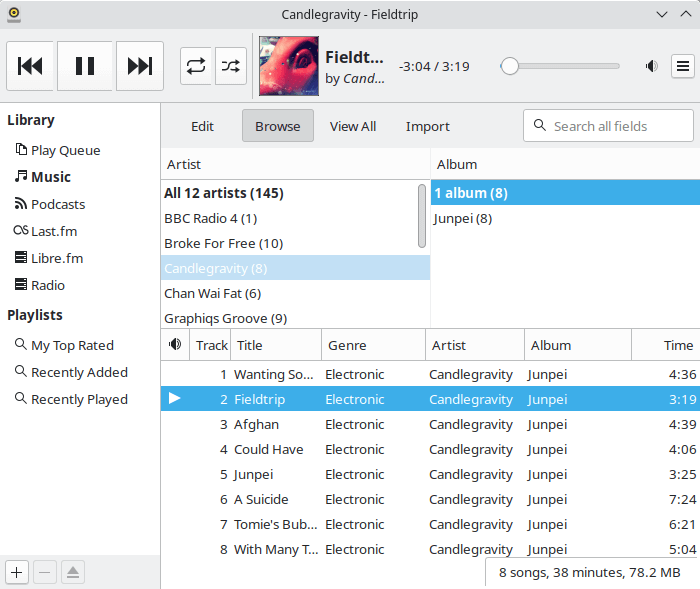Rhythmbox is an integrated music management application, originally inspired by Apple’s iTunes.
It is free software, designed to work well under the GNOME Desktop, and based on the powerful GStreamer media framework.
Rhythmbox uses the Linux Hardware Abstraction Layer (HAL) to detect player devices. It uses Amazon to look up artwork.
Features include:
- Built-in SHOUTcast directory browser.
- Easy to use music browser.
- Searching and sorting.
- Comprehensive audio format support through GStreamer.
- Internet Radio support including last.fm streams.
- Playlists.
- Display audio visualizations.
- Transfer music to and from iPod, MTP, and USB Mass Storage music players.
- Display album art and song lyrics downloaded from the internet.
- Play, rip, and burn audio CDs.
- Automatically download audio podcasts.
- Browse, preview, and download albums from Magnatune and Jamendo.
- Digital Audio Access Protocol (DAAP) sharing.
Rhythmbox has been extensively integrated with a number of external programs, services and devices including:
- Nautilus file manager context-menu integration.
- XChat via an XChat plugin. Rhythmbox XChat Announcer.
- Pidgin – Rhythmbox automatically updates the Pidgin user profile with details of the currently playing track.
- Gajim and Pidgin include options for automatically updating the user status with details of currently playing track.
- Music Applet, a GNOME panel applet that provides Rhythmbox playback controls from within the panel.
- Shuffle, a gDesklet providing an interface for Rhythmbox resembling an iPod Shuffle.
- Rhythmlet, another gDesklet that retrieves album art locally or from Amazon.com, has configurable display strings, playback controls, editable ratings and a seek bar.
- SideCandyRhythmbox, a gDesklet-based Rhythmbox control and SideCandy display.
- Rhythmbox XSLT allows the music library to be viewed as a web page.
- Drivel inserts the name of the track Rhythmbox is currently playing into a LiveJournal blog entry.
- Rhythmbox Tune Publisher publishes the currently playing Rhythmbox track to Jabber via the User Tune protocol (used by the Jabber World Map).
- Blue Remote allows Rhythmbox to be operated from a Bluetooth-enabled phone.
- FoxyTunes, a Firefox extension that provides Rhythmbox playback controls from within the web browser.
- Plugins for browsing and listening to Creative Commons licensed albums from Jamendo and Magnatune.
Website: wiki.gnome.org/Apps/Rhythmbox
Support: FAQ
Developer: Jorn Baayen, Paolo Borelli, Kenneth Christiansen, David Dollar, Christophe Fergeau, and more than 20 others
License: GNU General Public License v2.0

Rhythmbox is written in C. Learn C with our recommended free books and free tutorials.
Return to Music Players | Return to Podcast Tools | Return to Internet Radio
| Popular series | |
|---|---|
| The largest compilation of the best free and open source software in the universe. Each article is supplied with a legendary ratings chart helping you to make informed decisions. | |
| Hundreds of in-depth reviews offering our unbiased and expert opinion on software. We offer helpful and impartial information. | |
| The Big List of Active Linux Distros is a large compilation of actively developed Linux distributions. | |
| Replace proprietary software with open source alternatives: Google, Microsoft, Apple, Adobe, IBM, Autodesk, Oracle, Atlassian, Corel, Cisco, Intuit, SAS, Progress, Salesforce, and Citrix | |
| Awesome Free Linux Games Tools showcases a series of tools that making gaming on Linux a more pleasurable experience. This is a new series. | |
| Machine Learning explores practical applications of machine learning and deep learning from a Linux perspective. We've written reviews of more than 40 self-hosted apps. All are free and open source. | |
| New to Linux? Read our Linux for Starters series. We start right at the basics and teach you everything you need to know to get started with Linux. | |
| Alternatives to popular CLI tools showcases essential tools that are modern replacements for core Linux utilities. | |
| Essential Linux system tools focuses on small, indispensable utilities, useful for system administrators as well as regular users. | |
| Linux utilities to maximise your productivity. Small, indispensable tools, useful for anyone running a Linux machine. | |
| Surveys popular streaming services from a Linux perspective: Amazon Music Unlimited, Myuzi, Spotify, Deezer, Tidal. | |
| Saving Money with Linux looks at how you can reduce your energy bills running Linux. | |
| Home computers became commonplace in the 1980s. Emulate home computers including the Commodore 64, Amiga, Atari ST, ZX81, Amstrad CPC, and ZX Spectrum. | |
| Now and Then examines how promising open source software fared over the years. It can be a bumpy ride. | |
| Linux at Home looks at a range of home activities where Linux can play its part, making the most of our time at home, keeping active and engaged. | |
| Linux Candy reveals the lighter side of Linux. Have some fun and escape from the daily drudgery. | |
| Getting Started with Docker helps you master Docker, a set of platform as a service products that delivers software in packages called containers. | |
| Best Free Android Apps. We showcase free Android apps that are definitely worth downloading. There's a strict eligibility criteria for inclusion in this series. | |
| These best free books accelerate your learning of every programming language. Learn a new language today! | |
| These free tutorials offer the perfect tonic to our free programming books series. | |
| Linux Around The World showcases usergroups that are relevant to Linux enthusiasts. Great ways to meet up with fellow enthusiasts. | |
| Stars and Stripes is an occasional series looking at the impact of Linux in the USA. | |